The Huawei Mate 8 Review
by Andrei Frumusanu on January 5, 2016 1:00 PM EST- Posted in
- Mobile
- Smartphones
- Huawei
- Cortex A72
- Kirin 950
- Mate 8
- CES 2016
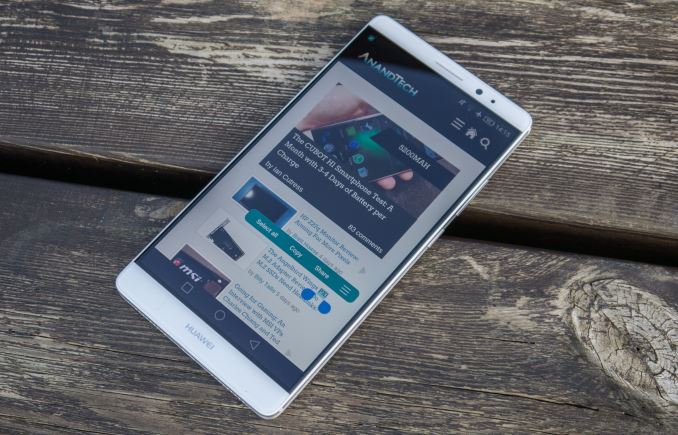
It’s been over a year since we reviewed the Huawei Ascend Mate 7 and Ascend Mate 2. For many people and including ourselves at AnandTech these were among one of the first experiences with Huawei as a smartphone device manufacturer. Ever since our review of the Honor 6 I kind of fell into the position of being the main editor in charge of Huawei device reviews and thus experienced first-hand the company’s efforts in the high-end as well as their increasingly visible expansion into western markets.
The Mate 8 is the successor to the Ascend Mate 7, and in a similar fashion to the P8 last spring the phone drops the Ascend name in favour of better establishing the Mate brand for Huawei's large premium phablet models. The Mate 8 is in a lot aspects an evolutionary design over the Mate 7, but at same time comes at the moment of a generational shift brought forth by the adoption of the new Kirin 950 SoC. With help of the new chipset and other improvements we’ll see that Mate 8 not only manages to raise the bar for Huawei but also to deal blows to competing devices in several aspects, making the phone a worthy candidate in the upcoming 2016 smartphone generation battle.
Introduction & Design
So let’s dive in for a comprehensive look at what Huawei has managed to bring this year for the Mate series and determine its strengths and possible weaknesses.
| Huawei Mate 8 | ||
| SoC | HiSilicon Kirin 950 4x Cortex A53 @ 1.8GHz 4x Cortex A72 @ 2.3GHz Mali-T880MP4 @ 900MHz |
|
| RAM | 3-4GB LPDDR4 @ 1333MHz | |
| NAND (NXT-AL10) |
32GB / 64GB / 128GB NAND + microSD |
|
| Display | 6” 1080p JDI IPS-Neo LCD | |
| Modem | 2G/3G/4G LTE Cat 6 (Integrated HiSilicon Balong Modem) |
|
| Networks (NXT-AL10) (NXT-L29) (NXT-L09) |
TDD LTE | B38 / B39 / B40 / B41 |
| FDD LTE | B1 / B2 / B3 / B4 / B5 / B6-B6 / B7 / B8 / B12 / B17 / B18 / B19 / B20 / B26 / B28 | |
| UMTS | 850 / 900 / AWS / 1900 / 2100 ( B19 / B8 / B6 / B5 / B4 / B2 / B1) |
|
| GSM | 850 / 900 / 1800 / 1900 | |
| Dimensions | 157.1 (h) x 80.6 (w) x 7.9 (d) mm 185g weight |
|
| Camera | Rear Camera w/ OIS 16MP ( 4608 × 3456 ) Sony IMX298 1/2.8" w/ 1.12µm pixels F/2.0 aperture, 27mm eq. |
|
| Front Facing Camera 8MP ( 3264 × 2448 ) Sony IMX179 1/3.2" w/ 1.4µm pixels F/2.4 aperture, 26mm eq. |
||
| Battery | 4000mAh (15.2 Whr) | |
| OS | Android 6.0 with EmotionUI 4.0 |
|
| Connectivity | 802.11a/b/g/n/ac dual-band 2.4 & 5GHz BT 4.2, microUSB2.0, GPS/GNSS, DLNA, NFC |
|
| SIM Size | NanoSIM + NanoSIM (w/o microSD) (NXT-L09 is single-SIM) |
|
| MSRP | 3GB + 32GB | China: ¥2999-3199 (USD~479, ~449€) - Europe: 599€ |
| 4GB + 64GB | China: ¥3699 (USD~591, ~554€) - Europe: 699€ | |
| 4GB + 128GB | China: ¥4399 (USD~703, ~659€) - Europe: N/A | |
At the heart of the Mate 8 we find HiSilicon’s new Kirin 950 SoC. We were lucky enough to be one of the few western media outlets able to attend the SoC’s launch event in Beijing earlier in November and deliver an in-depth look at what the new chipset promises in terms of improvements over past Kirin generations. As a short overview, the Kirin 950 is a big.LITTLE SoC with the first mobile implementation of ARM’s Cortex A72 cores in a quad-core configuration clocked in at 2.3GHz, accompanied by a quad-core Cortex A53 at 1.8GHz acting as the little cluster. Graphics is powered by a Mali T880MP4 GPU with a frequency of 900MHz. Past Huawei devices’ major weak-points were related to the choice of SoC and as we’ll see shortly in the dedicated SoC section we’ll see that HiSilicon was able to fulfil and even exceed some of our expectations of both ARM’s new Cortex A72 as well as the Kirin chipset as a whole.
In terms of memory the Mate 8 comes in either 3 or 4GB RAM variants, depending on whether one chooses the 32 or the larger 64GB and 128GB NAND storage models. Expandable storage is par for the course as we have a combo-dual SIM slot with the choice of either employing a second (2G only) nanoSIM or to use the slot as a microSD card expansion.
Going over the design we see a front exterior that doesn’t change all that much when compared to the Mate 7, with only subtle details being able to give hints that this is a new model. Keeping the same form-factor, the Mate 8 maintains a fairly large size coming in at 157.1 x 80.6 x 7.9mm. Even though the device is large, it’s able to sport a very good screen-to-body ratio for the large 6” 1080p JDI Neo-IPS screen. The top and bottom bezels particularly make the Mate 8 quite short compared to other devices of similar screen size.
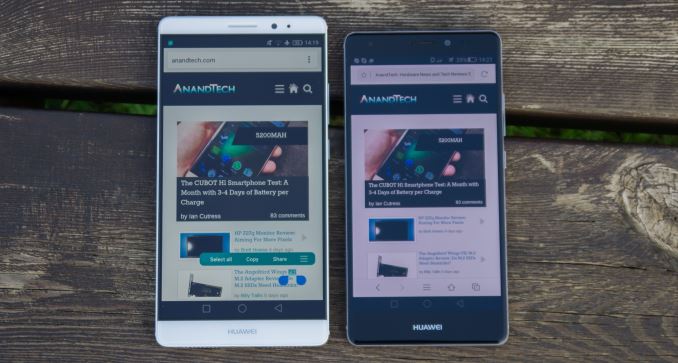
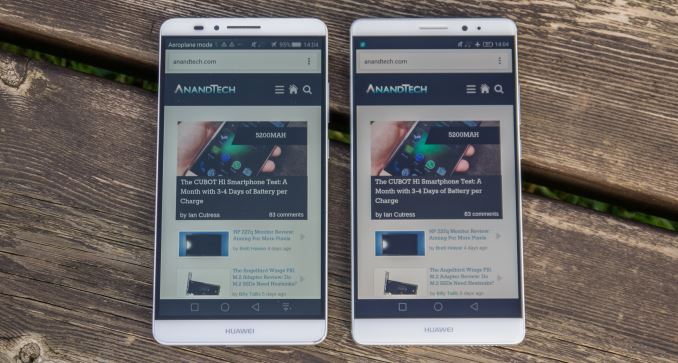
Mate 8 vs Mate S - Mate 7 vs Mate 8
A rather disappointing continuation of the Mate 7 design is the reintroduction of a ~2.5mm thick inactive black border around the screen that is found on all colour-variants of the phone. This creates a quite distracting window-frame effect on the lighter coloured models. I wish Huawei had been able to get rid of the distracting feature or at least chosen to keep the front all black for all colour models.
It’s on the back and sides where we see the Mate 8 diverge from the Mate 7’s features as there are several design language changes for the various components. First of all the square trio of camera lens, LED flash as well as fingerprint sensor have now become circular. The finger-print sensor saw the biggest design change as the is no longer a visible metal rim around it and is now similar to the one found on the Mate S and Nexus 6P. Previously the feature on the Mate 7 was described as being used to detect one’s finger while the device and fingerprint sensor were asleep, something the new models either are able to camouflage away or outright no longer require. The Mate 8 also was able to dispose of the small gap above the camera which served as an antenna line for the NFC coil, all while still keeping NFC funtionality.
The main camera is now powered by a Sony IMX298 16MP sensor module with OIS and an F/2.0 aperture optical lens system. This is a normal Bayer RGB sensor as opposed to last year’s main usage of the RGBW IMX278. Huawei also drops the usage of an external Altek ISP and instead relies on the Kirin 950’s new ISP capabilities. The front camera remains the same IMX179 F/2.4 8MP module as found on the P8, Mate S and Nexus 6P which I found to take excellent front-facing shots.
The top and bottom of the phone is no longer wholly composed of plastic covers that go over the sides of the device, but is now composed of aluminium separated by antenna lines on the sides and with a plastic lid on the back side. In a sense this design stands out less than the antenna lines on the Mate S and may be the rationale behind the choice. On all sides we find a coarse brushed metal finish (actual brushed metal) that gives the device much firmer grip than other devices but is also harder to clean if dirtied by fine elements.
The speaker is moved from the back of the phone onto the bottom, much in the same layout as found on the P8 and Mate S. Also the same as the previous designs who introduced this new layout, there’s only one speaker to be found as the other grill only serves for aesthetical symmetry and the main microphone.
A large ergonomic improvement is found on the sides of the device as the new 2.5D glass screen is no longer surrounded by a raised plastic edge but instead uses the same hard compound filling between the glass and metal body. The back also has a curvature of a larger radius, which together with the 2.5D glass gives the impression of a thinner device although the Mate 8 isn't any thinner than the Mate 7 at its maximum thickness.
My sample was a 32GB silver variant, so I can only comment on the finish of this model; I found that the new anodized aluminium finish to be quite hard to clean as dirt was very easy to stick to the grain of the metal. The positive side of this characteristic was that the device was much better to grip than the comparatively smoother finish of the silver Mate 7, with the gunmetal grey of the Mate S representing a happy medium between both designs.


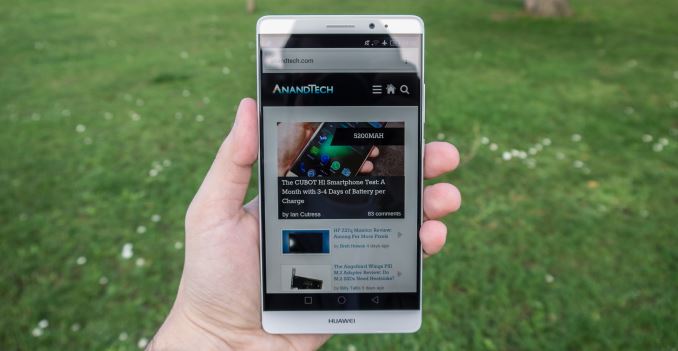

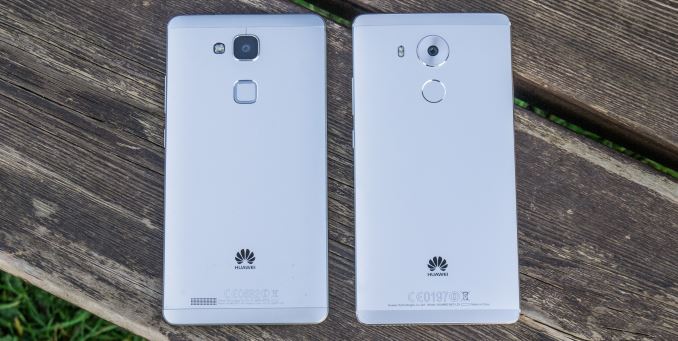
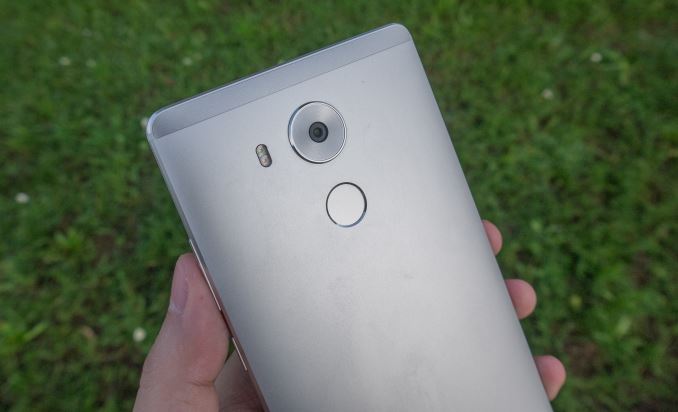
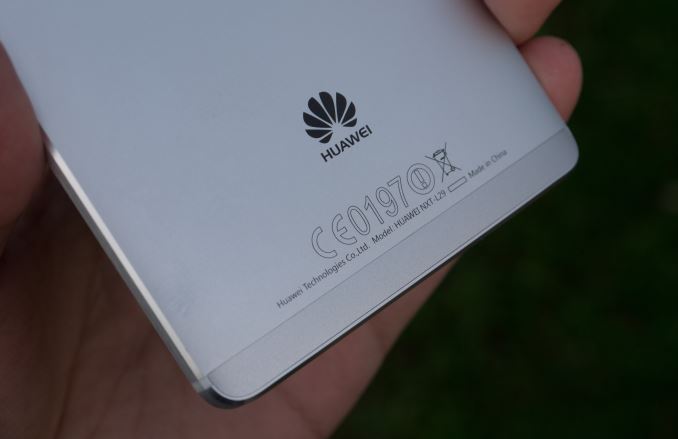



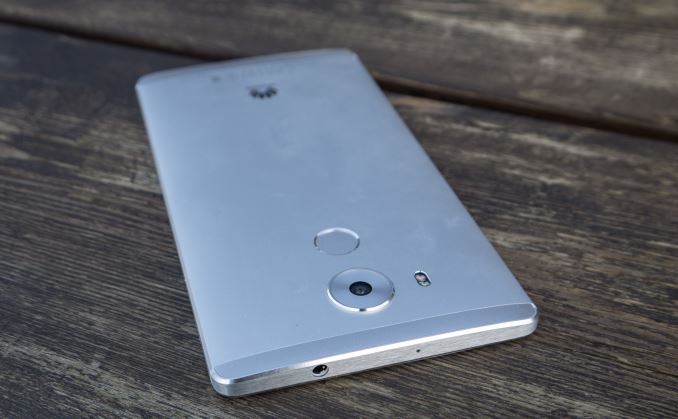
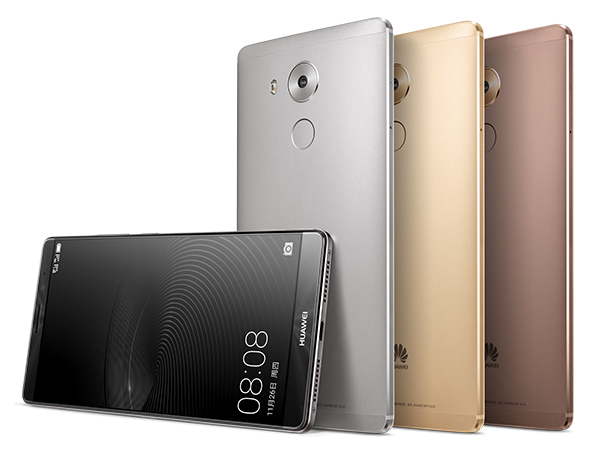
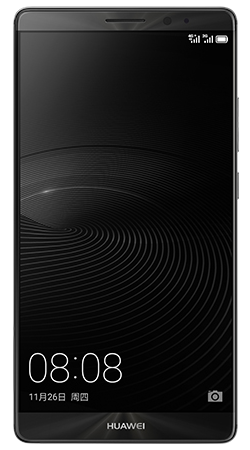








116 Comments
View All Comments
s.yu - Saturday, January 16, 2016 - link
Which will soon become among the slowest of all flagship CPUs. Please, it's one generation above Exynos 7420 (courtesy of ARM) and still doesn't beat it in all aspects.MrSpadge - Tuesday, January 5, 2016 - link
I don't think it makes any sense yet to name "phones" and "high end games" in the same sentence. (still doing it right now)beachletter - Tuesday, January 12, 2016 - link
The mate 8 achieved similar if not better sustained framerates than the Exynos 7420 in demanding games like nba 2k15/2k16. And that is when the 7420 is also running on 1080p, not 2k (Meizu Pro 5).I'd say GPU on the 950 is totally comparable to Exynos 74xx in actual gameplay because it has so little thermal throttling. In fact, it is probably superior to some phones using snapdragon 810, especially after a few minutes of playtime and on 2k screens. I know because I have a Oneplus 2 which plays like shit after 10-15 minutes game time.
This GPU won't compete with 2016 flagship SoCs, but it can easily match the high end chips currently available in actual usage. The graphics benchmark really don't tell you the whole story.
Lolimaster - Tuesday, January 5, 2016 - link
It seems only Apple, Samsung and maybe Xiaomi cares about display accuracy which is better than focusing on gizmos.5th element - Tuesday, January 5, 2016 - link
Google's devices arent half bad, but I agree with you display accuracy should be of primary concern and I, for the life of me, have no idea why it isn't an this extends right across the board to LCD TVs and monitors.ChronoReverse - Tuesday, January 5, 2016 - link
The reason is because more people prefer the overly saturated colours. The most common comment I get when people look at my previous phones where the colours were set to as accurate as possible for that model is "why does it look washed out?".This is why a screen capable of colour accuracy like the Nexus 6P ends up with a saturated default setting.
s.yu - Saturday, January 16, 2016 - link
That's why Samsung's approach with multiple screen modes makes so much sense. Most will leave it on Adaptive, those who care will change it to Basic or AMOLED Photo. Those watching really badly compressed videos could use AMOLED Cinema.s.yu - Saturday, January 16, 2016 - link
One up that!NZtechfreak - Tuesday, January 5, 2016 - link
I've had one of these for nearly three weeks, a 4gb/64gb one (coming from Note 4 and Nexus 6P previously). This review aligns with my experience. Battery life is easily the best I've had, in the same use it is basically doubling what I had with the Note 4 and 6P. Battery life is fairly high on my priority list and this device is a breath of fresh air in this regard. I had noticed the camera issues, but hadn't picked the reason until Andreilux informed me a few days ago. I'm on a newer B129SP02 firmware, which somewhat ameliorates the issue but not as successfully as it needs to. I think this should be able to be resolved in firmware though, so hopefully will see more of the sensors potential in upcoming updates (I've had three firmware updates so far, so certainly they are moving at a reasonable pace to address issues thusfar). Can update as more firmwares come in if people are interested. Regards the screen my subjective experience matches the review. Coming from the Note 4 in basic screen mode and the 6P in sRGB mode, the garish colours are a bit of an eyesore. Not sure if you mentioned it, but the screen is fairly reflective too, so despite a reasonable brightness sunlight viewing is mildly irritating at times. Blacks for a non-AMOLED screen are sufficient for me, white on warmest colour temp also good enough for me. Overall though the panels performance is acceptable for me. The last firmware update changelog mentioned changes to the colour temp adjustment, but I'm not perceiving a difference. I hope they can refine colour temp adjustment further with firmware updates. Again, not sure if I missed it, but the speaker performance here is really enjoyable - best bass I have heard from a smartphone till now. Speaker performace gets noticeably stressed as you approach 70%+ of the volume range, but volume is plentiful enough beneath that to not give me cause for concern. Pleased with your GPU write-up, a balanced viewpoint (it matches my own, so I suppose I would say that). While GPU performance is not wonderful in raw terms, it exceeds most devices this year for native resolution workloads on account of the 1080p screen. Throttling behaviour is particularly pleasing, since I do mostly emulator gaming on my phone and it's really nice playing the Gamecube's Fire Emblem Path of Radiance at fullspeed here (Dolphin overclock setting at 0.2). Overall I'm well pleased, the camera issue needs resolution, but I use my GH3 for when I really want to take nice shots, so for me it isn't the showstopper that it will be for some on current software.name99 - Tuesday, January 5, 2016 - link
"One characteristic that might be defining for the Kirin 950 is that it still uses a CCI-400 fabric"Might I suggest as a future article one that clarifies what the relationship is between all these ARM terms. We have AMBA, CHI, ACE, CCI and probably a few more I've forgotten. They all seem to have something to do with coherency between different "ARM ecosystem" cells, but what exactly, and how are they all related?